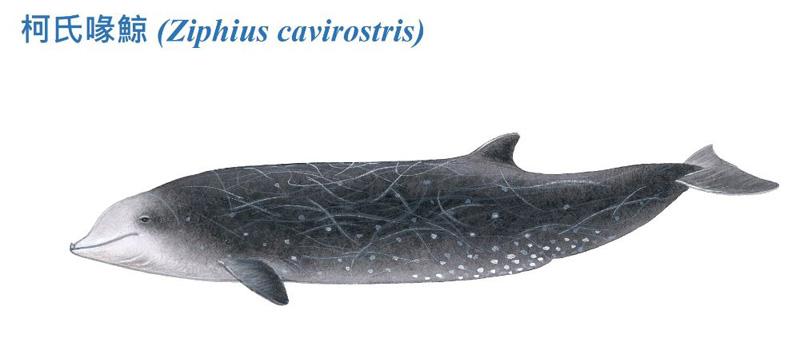Ziphius cavirostris
IUCN
LCBasic Information
Scientific classification
- name:Ziphius cavirostris
- Scientific Name:Ziphius cavirostris,Cuvier's beaked Whale,Cuvier's beaked whale, goose-billed whale, Cuvier's beaked whale, goose-billed whale, Cuvier's beaked whale
- Outline:Cetacea
- Family:B.whale
Vital signs
- length:7-7.5
- Weight:3000kg
- lifetime:40-60years
Feature
The diving depth champion among mammals, the highest record is 2992 meters
Distribution and Habitat
Cuvier's beaked whales are found all over the world, except in high latitudes near the poles, mainly in deep tropical to cold temperate waters. Strandings have been found all over the world, including in the North Atlantic, including the United Kingdom, France, Spain, Portugal, the eastern United States, the Caribbean, and even the Mediterranean; there are fewer records in the South Atlantic, as far south as Tierra del Fuego at the southern tip of South America. In the Pacific, from the Aleutian Islands and Baja California to southern Chile, as well as Hawaii, Japan, Australia, and New Zealand. They are seasonal in the southern Bay of Biscay, where they are mainly seen in late winter and spring (February to May), concentrated in a narrow latitude range (43°30' to 45°30'N) at depths of 1,500 to 3,000 meters. They seem to have very specific habitat requirements, such as waters with highly variable seafloor slope gradients.
Appearance
The length of the whale is 2.7 meters at birth, and the adult male can reach 7.5 meters, and the adult female is 7 meters, and the weight can reach nearly 3,000 kilograms. The head of Cuvier's beaked whale is very easy to distinguish from other beaked whales. The beak is very short, without a prominent forehead, and the lower jaw ends beyond the upper jaw. The male has a pair of conical teeth exposed in the front of the lower jaw, while the female whale's teeth are generally not exposed. It rises steeply from the tip of the upper snout to the frontal ridge, with a concave respiratory aperture, then slowly rises and stretches backward; the dorsal fin is sickle-shaped, located 2/3 of the way from the tip of the snout to the back of the body, with a blunt tip and a slightly concave rear edge. The dorsal fin height is 4.5% of the body length, and the base of the dorsal fin is relatively short, accounting for 7.1% of the body length; the pectoral fins are relatively small, with lo
Details
Cuvier's beaked whale, whose foreign name is Cuvier's beaked Whale, is the most widely distributed species in the beaked whale family. They are also known as Goose-beaked Whale and Goose-billed Whale, so named because their head looks somewhat like a goose's head when viewed from the side. The species name "cavirostris" is derived from the Latin "cavus", which means "hollow" or "depressed", reflecting the depression of the forehead and nasal bones of male whales.

Cuvier's beaked whales usually live alone or in small groups of about 3 to 12, and up to 25 in the main feeding area. Its jets are low and divergent, appearing rather blurry on the sea surface. They have been seen leaping into the waves at a few locations. They can dive for 20-40 minutes, up to 2 hours, and the maximum diving depth can reach 2992 meters. They are the diving champions among mammals. It puffs once every 10-20 seconds on the sea surface. It is generally speculated that they dive deep to avoid approaching ships, so if you want to observe, it is best to approach from behind.
Cuvier's beaked whales have more stranding records than other beaked whales, with mass strandings recorded in Costa Rica and the Galapagos Islands.
Autumn seems to be the peak breeding season for Cuvier's beaked whales, and almost nothing is known about the rest.
It is generally believed that Cuvier's beaked whales mainly eat squid at a depth of 1,000 meters, but studies of its stomach contents have found that fish seem to account for a large proportion, and crustaceans may also be consumed. Because they do not have functional teeth, Cuvier's beaked whales should hunt by suction, and the same may be true for other beaked whales.
Because Cuvier's beaked whales are difficult to detect or identify, their numbers are unknown. Surveys on the west coast of the United States show that there are thousands of them inhabiting the area. Compared with other beaked whales, Cuvier's beaked whales are more affected by human activities due to their wide distribution and high occurrence rate. Japan once captured a small number of Cuvier's beaked whales, with an annual catch of 3-35, mostly captured by whalers that hunted Belvedere's beaked whales. 67% of them are males, but this data is not enough to explain the actual sex ratio of the population. In addition, they may become trapped in gill nets in deep waters and die. There is strong suspicion that they lack resistance to special noises, which could easily threaten their survival near industrial areas, military areas, or even game areas.
It has been listed in the International Union for Conservation of Nature (IUCN) Red List of Threatened Species (2017) - Species of Least Concern (LC).
It is listed as Level 2 in the "List of National Key Protected Wild Animals in China".
Protect wild animals and eliminate wild game.
Maintaining ecological balance is everyone’s responsibility!








